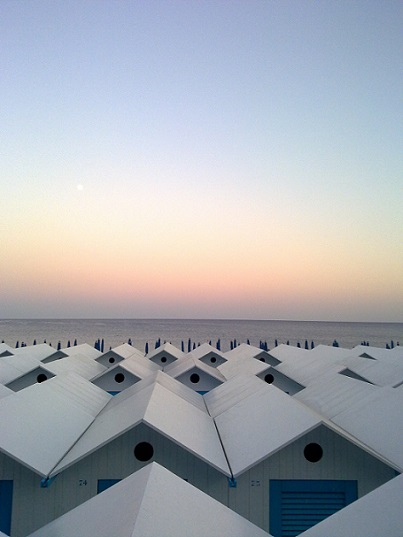Space, place and atmosphere. Emotion and peripherical perception in architectural experience
DOI:
https://doi.org/10.13130/2240-9599/4202Abstract
Architectural experiences are essentially multi-sensory and simultaneous, and a complex entity is usually grasped as an atmosphere, ambience or feeling. In fact, the judgement concerning the character of a space or place calls for categories of sensing that extend beyond the five Aristotelian senses, such as the embodied existential sense, and, as a result, the entity is perceived in a diffuse, peripheral and unconscious manner. Paradoxically, we grasp an atmosphere before we have consciously identified its constituent factors and ingredients. «We perceive atmospheres through our emotional sensibility – a form of perception that works incredibly quickly, and which we humans evidently need to help us survive», Peter Zumthor suggests. We are mentally and emotionally affected by works of art before we understand them, or we may not understand them intellectually at all. Sensitive artists and architects intuit experiential and emotive qualities of spaces, places and images. This capacity calls for a specific kind of imagination, an emphatic imagination. Atmospheres are percieved peripherally through diffuse vision interacting with other sense modalities, and they are experienced emotionally rather than intellectually. The studies on the differentiation of the two brain hemispheres suggest that atmospheres are perceived through the right hemisphere. Somewhat surprisingly, atmospheres are more conscious objectives in literature, cinema, theater, painting and music than in architecture, which has been traditionally approached formally and perceived primarily through focused vision. Yet, when we see a thing in focus, we are outsiders to it, whereas the experience of being in a space calls for peripheral and unfocused perception. One of the reasons for the experiential poverty of contemporary settings could be in the poverty of their peripheral stimuli.
Riferimenti bibliografici
AALTO, Alvar, The trout and the mountain stream, in Alvar Aalto sketches, ed. by G. Schildt, Cambridge, The MIT Press, 1985.
BACHELARD, Gaston, The poetics of space, Boston, Beacon Press, 1969.
BACHELARD, Gaston, Water and dreams: an essay on the imagination of matter, Dallas, The Pegasus Foundation, 1983.
BÖHME, Gernot, Atmosphäre, Frankfurt am Main, Suhrkamp Verlag, 1995.
BÖHME, Gernot, Architektur und Atmosphäre, München, Fink, 2006.
D’ANNUNZIO, Gabriele, Contemplazioni della morte, Milano, Fratelli Treves, 1912.
EHRENZWEIG, Anton, The psychoanalysis of artistic vision and hearing: an introduction to a theory of unconscious perception, London, Routledge & Paul, 1953.
EHRENZWEIG, Anton, The hidden order of art, Berkeley, University of California Press, 1970.
GARDNER, Howard E., Intelligence reframed: multiple intelligences for the 21st century, New York, Basic Books, 1999.
HEIDEGGER, Martin, Building, dwelling, thinking, in Id., Basic Writings, New York, Harper & Row, 1997.
HILDEBRAND, Grant, The origins of architectural pleasure, Berkeley - Los Angeles - London, University of California Press, 1999.
HILDEBRAND, Grant, The Wright space: pattern and meaning in Frank Lloyd Wright’s houses, Seattle, University of Washington Press, 1992.
HISS, Tony, The experience of place, New York, Random House, 1991.
JOHNSON, Mark, The meaning of the body: aesthetics of human understanding, Chicago - London, The University of Chicago Press, 2007.
KLEE, Paul, in Thinking eye, New York, Wittenborn, 1964.
MCGILCHRIST, Iain, The master and his emissary: the divided brain and the making of the Western world, New Haven - London, Yale University Press, 2009.
MARCUSE, Herbert, The one-dimensional man: studies in the ideology of advanced industrial society, Boston, Beacon Press, 1991.
MERLEAU-PONTY, Maurice, The film and the new psychology, in Id., Sense and non-sense, Evanston, Northwestern University Press, 1964.
PALLASMAA, Juhani, In praise of vagueness: diffuse perception and uncertain thought, Austin, University of Texas Press, 2011.
POGUE HARRISON, Robert, Gardens: an essay on the human condition, Chicago - London, The University of Chicago Press, 2008.
SCHMITZ, Hermann, System der Philosophie, Bd. III: Der Raum, 2, Teil: Der Gefühlsraum, Bonn, Bouvier, 1969.
WILSON, Edward O., The right place, in Id., Biophilia, Cambridge, Harvard University Press, 1984.
ZAJONC, Arthur, Catching the light: the entwined history of light and mind, New York - Oxford, Oxford University Press,1995.
ZEKI, Semir, Inner vision: an exploration of art and the brain, Oxford, Oxford University Press, 1999.
ZUMTHOR, Peter, Atmospheres – Architectural environments – Surrounding objects, Basel - Boston - Berlin, Birkhäuser, 2006.



